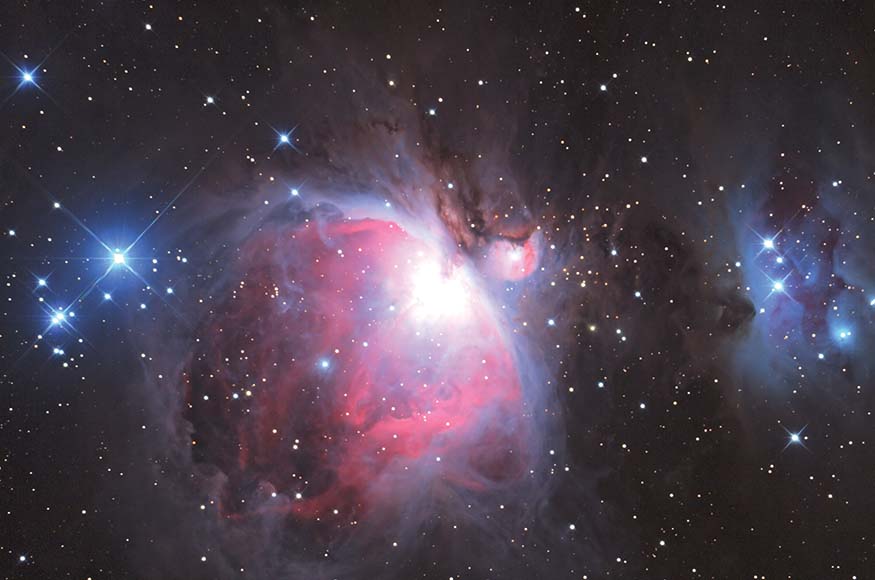
BEAUTY: 
BRAGGING RIGHTS: You saw a star factory!
HOW EASY IS IT TO SEE? Best with a small telescope
BEST TIME TO SEE IT: Winter (in Orion)
TYPE: Diffuse Nebula
DISCOVERED: 1611 by Nicolas-Claude Fabri de Peiresc
If you look at Orion on a clear winter night, you might notice that the middle of the three stars in Orion’s sword is a little fuzzy. With averted vision, the star seems to grow into a tiny little cloud.
And yet, when Greek astronomers plotted this region of the sky 2,000 years ago, they made no mention of any nebula. The Arab astronomer Al-Sufi noticed the fainter Andromeda “nebula” but made no mention of anything in Orion. Even in 1609, when Galileo looked at Orion’s sword with his newly created telescope, he saw nothing but stars. It wasn’t until 1611 that Frenchman Fabri de Peiresc finally saw the nebula with his (presumably better) telescope.
Why so many people in the past missed seeing the Great Orion Nebula, a pretty obvious sight for observers today, is a minor mystery in astronomy.
The Orion Nebula, also known as Messier 42 (or M42), is a star factory about 1,300 light-years away. This vast cloud of gas and dust has condensed, via the force of gravity, into newly born stars. Many of these stars are hidden inside dark clouds, but others shine brightly and illuminate the surrounding nebula.
In 100,000 years or so, these newborn stars will burn away the surrounding nebula, and they’ll shine alone against the black night. By then the Orion Nebula will be no more and we’ll see only a bright cluster of stars, perhaps like the Pleiades today. Eventually, the gravitational eddies of the galaxy will break the cluster apart and the stars of the nebula will wander the galaxy alone, just as our sun does now.
WHAT YOU MIGHT SEE THROUGH AMATEUR EQUIPMENT
The Great Orion Nebula is the best nebula visible from the Northern Hemisphere—only the Southern Hemisphere’s Eta Carina Nebula outranks it, and even then I think M42 has a more beautiful and symmetrical shape.
Binoculars or a small telescope are best; large telescopes magnify too much to see the whole nebula. Dark, moonless skies are recommended, but the core of M42 is bright enough to punch through moderate light pollution. No matter where you are, it’s probably worth it to give the Orion Nebula a look.
You won’t see much, if any, color—nebulae are too faint to excite the eye’s color receptors. Fortunately, the Orion Nebula is also bright enough to be an easy target for astrophotography. Other than the moon, there probably is no easier target. With sufficient exposure, you should get some color—mostly pinks and purples—in your astrophotos.
Head and wings. The basic shape of the nebula will be obvious on your first view. The heart of the nebula is bright and square, with a small cut, like a mouth. It is flanked by two wings, like those of a ghostly manta ray. Above the heart you’ll see a bright knot of nebulosity, technically given its own designation—Messier 43—but it’s really just part of the same complex.
Trapezium. With a little bit of magnification, you’ll see that the heart of the nebula has four bright stars in a rough trapezoidal shape, hence its colloquial name, Trapezium.
These four stars have already blown away the surrounding nebula gases, which is why we can see them clearly. They also provide the illumination for the rest of the nebula.
With larger telescopes, you might see two additional stars in Trapezium.
How much can you see? The complex structure of the Orion Nebula is beautiful in long-exposure photos, but even with a small telescope you should be able to discern a lot of detail.
Start at the center and try to trace the edges of the nebula. The edges of the wings appear bright, but they fade. How far can you trace them? In really dark skies you might just be able to see that one of the wings wraps almost 180 degrees around the nebula.
ORION REGION IN WINTER; 30-DEGREE FIELD OF VIEW